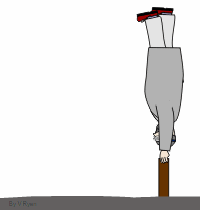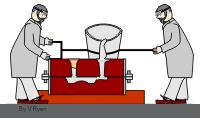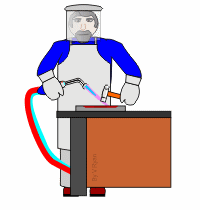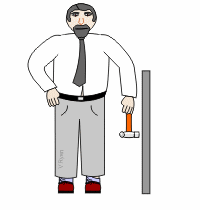When studying materials and especially when selecting materials for a project / design, it is important to understand key properties. The most important properties are outlined below.
| STRENGTH | |
|
The ability of a material to stand up to forces being applied without it bending, breaking, shattering or deforming in any way. Our technology technician (Ed) demonstrates the ‘strength’ of a material by performing a hand stand on a strong piece of timber (wood). It does not bend even under his weight. He has eaten pies and drunk a large amount of beer for twenty years and yet the strong material does not bend, flex or deform (change shape) in any way. |
 |
| ELASTICITY | |
|
The ability of a material to absorb force and flex in different directions, returning to its original position. Our technology technician demonstrates the ‘elasticity’ of a material by springing up and down on a piece of steel rod. Do not try this at home as an accident may result. Ed our technician is an expert at demonstrating this property as it is his hobby. |
 |
| PLASTICITY | |
|
The ability of a material to be change in shape permanently. Our technology technician and his twin brother demonstrate the ‘plasticity’ of a molten aluminium by pouring it into a mould. Once the aluminium has cooled down, it can be removed from the casting sand. It has a new shape. Our technician is often seen scavenging in dust bins after aluminum drinks cans. He then melts them down to form blocks (ingots) of aluminium to sell to scrap metal dealers. |
 |
| DUCTILITY | |
|
The ability of a material to change shape (deform) usually by stretching along its length. Our technician stretches the lead above his head. As it stretches if deforms (changes shape). Ed thinks he is a strong man, little does he realise that lead is a very soft metal and stretches very easily. He performs these tricks in local pubs in an attempt to pass himself off as a ‘hard man’. |
 |
| TENSILE STRENGTH | |
|
The ability of a material to stretch without breaking or snapping. Our technology technician demonstrates ‘tensile strength’ by stretching a piece of steel until it snaps. Ed thinks he is incredibly strong. However, his friends at work have substituted a sausage in place of the steel. |
 |
| MALLEABILITY | |
|
The ability of a material to be reshaped in all directions without cracking Our technology technician demonstrates the ‘malleability’ of a material by heating a piece of mild steel until it is red hot. He then beats it with a large forging hammer to reshape it. Because of the high temperature it reaches while heating the steel becomes malleable, it can be reshaped permanently. Ed often heats up steel, because he likes the colour and it matches his complexion after he has run up the stairs. |
 |
| TOUGHNESS | |
|
A characteristic of a material that does not break or shatter when receiving a blow or under a sudden shock. Our technology technician demonstrates the ‘toughness’ of a material by hitting a piece or material to see if it will break or shatter. Ed has been known to test authentic Chinese Ming Dynasty pottery with the same technique. This is why he is often arrested in Museums and has been banned from the local Antique dealers. |

|
| HARDNESS | |
|
The ability of a material to resist scratching, wear and tear and indentation. Our technology technician, dressed in a kilt, slides along the floor to see if it will scratch. It will be considered to hard wearing if it resists scratching. Ed has been known to fall over. Not a sight for sore eyes. |

|
| CONDUCTIVITY | |
|
The ability of a material to conduct electricity. Our technology technician demonstrates ‘conductivity’ by pressing live wires against either side of his head (PLEASE NOTE – THIS WILL KILL NORMAL PEOPLE). Ed survives because his skull is empty. |

|